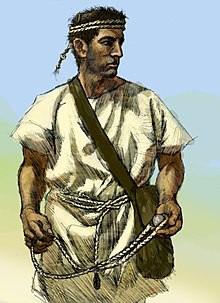Balearic slinger
This article includes alist of references,related reading,orexternal links,but its sources remain unclear because it lacksinline citations.(February 2024) |

TheBalearic slingers,indigenous to theBalearic Islands,werewarriorsfrom ancient times famed for their mastery in the art of using thesling.They also served asmercenariesfor bothCarthaginianandRoman forces,particularly during the post-Talayotic era.
They played a role in thewarsagainst theGreeksinSicilyand theSecond Punic War,including theBattle of Baecula.Later, they served as light infantry auxiliaries in various battles, includingJulius Caesar's legions in theGallic Wars.Initiallyrecruited voluntarily,conflicts with the Balearic populations arose during the final phase of thePunic Wars,leading to forcedconscriptions,especially inMenorca.
History
[edit]Carthaginian army
[edit]They are first mentioned in the mid-4th century BCE inSardiniaand during the conquest ofSelinunte(409 BCE) in the context of theSecond Sicilian War.Diodorus Siculusplaces them among Carthaginian fighters during the capture ofAgrigentoand, already in theThird Sicilian War,in the Battle of Ecnomus (310 BCE), under the command ofHamilcar,son ofGisco.
According to chroniclers,Hannibalhad approximately 2000 Balearic slingers, positioned at the forefront of his army during the early stages of theItaliancampaign, responsible for initiating the fight to harass the Romans. It is noteworthy that the Balearic slinger contingents were explicitly mentioned in Hannibal's troop distribution before leaving command of the Carthaginian territory in theIberian Peninsulato his brotherHasdrubal,to whom he entrusted 500 Balearic slingers. Hannibal attached great importance to these troops and protected them throughout the campaign as irreplaceable soldiers. The reason for their military effectiveness lay in the greater range and precision of the sling compared to thebow.
Roman army
[edit]After the Roman conquest of the Balearic Islands, historical sources again mention the slingers, now integrated into the Roman army.Gaius Sallustiusinforms us of Balearic slingers among Roman troops fighting inNumidiaagainstKing Jugurtha(111–105 BCE). Caesar mentions Balearic slingers as fighters in theGallic Warsaround 56 BCE, fighting alongside other elite troops such asNumidiancavalryandCretan archers.
In classical sources
[edit]The Balearic slingers are documented in the works ofStrabo,Diodorus Siculus,Florus,Livy,Polybius,andZonaras.Virgilmentions them inThe Georgics,andOvidinMetamorphoses.In the modern era,Miquel Costa i Lloberamentioned them in several of his odes concerning the traditions and culture ofMallorca.
Equipment and weapon
[edit]
They were equipped with agoat skinshieldand aniron-tipped or fire-hardenedjavelinfor close combat. In battle, they used three slings: one was larger for longer shots, worn around the waist; another of medium size was held in the hand; and a smaller one for close-range shots, worn on the head. The projectile could be launched in different ways, but they essentially had three types of shots (one for each sling). The slings were (and still are) made from cord, with six segments of cord, resembling abraid.The projectiles, calledglandes,were launched after three spins of their slings and could be made ofstone,terracotta,orlead.They could weigh up to 500 g (1.1 lb), and their effects on enemy troops were powerful.
References
[edit]- Conselleria de Cultura del Govern Balear (1992).La Prehistòria de les Illes de la Mediterrània Occidental(in Catalan). Palma de Mallorca.
{{cite book}}:CS1 maint: location missing publisher (link) - Rosselló Bordoy, Guillem (1979).La cultura talayótica en Mallorca(in Spanish). Palma de Mallorca: Cort.ISBN9788485049295.
- Nadal Cañellas, Joan (2000).Els foners balears(in Catalan). Palma de Mallorca: Grup Serra.OCLC777179224.
- Blázquez, José María; Alvar Ezquerra, Jaime; Wagner, Carlos González (1999).Fenicios y cartagineses en el Mediterráneo(in Spanish). Madrid: Cátedra.ISBN9788437617312.
